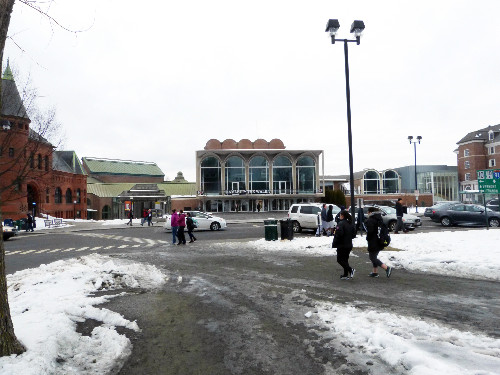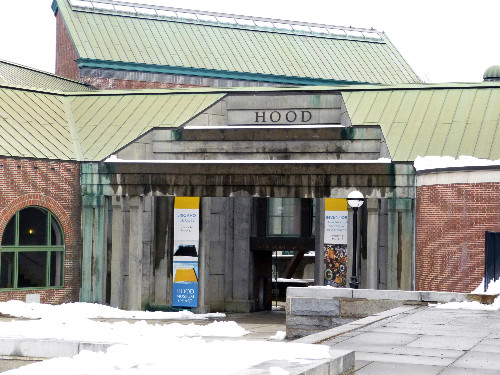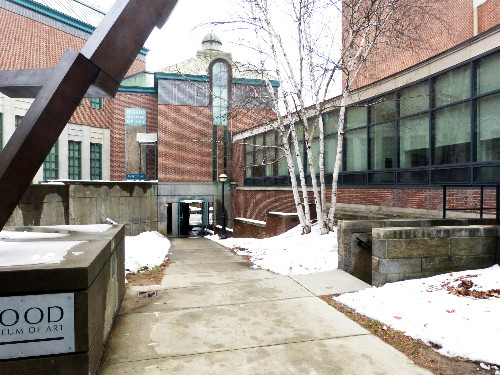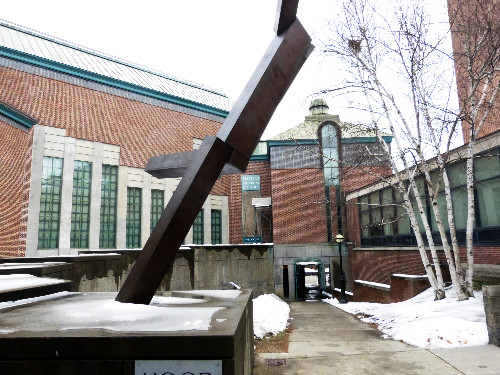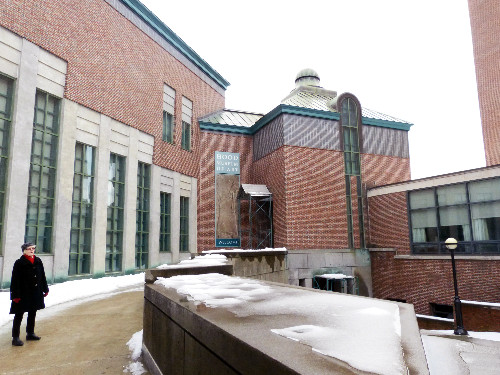John Stomberg Discusses Hood Museum
51 Million Expansion Designed by Tod Williams and Billie Tsien
By: Charles Giuliano - Jan 13, 2016
For the Hood Art Museum and Williams College Museum of Art in the mid 1980s, the architect Charles Moore (October 31, 1925 – December 16, 1993) was given challenging and restrictive footprints to create compact, exquisite jewel box museums.
Again, more or less simultaneously, both museums are expanding. There will be groundbreaking this summer in Hanover while plans for a likely relocation of its museum are still developing in Williamstown.
It was my pleasure to interview Moore on several occasions at Dartmouth. He was somewhat reticent but I spent quality time observing while he installed a selection from his vast antique toy collection. It was a holiday themed show at the Hood.
Decades had lapsed since we spent a day in Hanover this past weekend.
So much time in fact that I had to ask for directions to the museum. We were very close, standing on the edge of the main quadrangle, but it was less than obvious. "It's over there, between those buildings" our guide pointed out. "You go down through that arch, do you see it? Then the entrance is on the other side."
Which is one of the issues that the new $51 million project, designed by Tod Williams and Billie Tsien, hope to correct. The renovated museum is intended to be more visible and inviting.
We made our way through a relatively narrow arch with the name of the museum above.
That widens into a somewhat cockamamie courtyard. You wind around in a U turn and find the somewhat obscure entrance on the other side. Rather helter skelter there is an abstracted, stick figure, bronze sculpture by Joel Shapiro.
It is a somewhat lackluster signifier that we are about to enter an art museum.
Once inside, the apparent point of these existential aesthetics, we are indeed enthralled by the deliciously designed flow of galleries, on two levels, flanked by a signature staircase. One first enters a room that generously displays, with pride of place, a series of monumental ancient Assyrian reliefs. Left and right are galleries with selections from the permanent collection.
On the second level is a monumental central gallery for special exhibitions. Flanking off from it are more modestly proportioned galleries. The plan calls for five new galleries and a forty to fifty percent increase of exhibition space.
The galleries will be cleared for renovation at the end of March.
By phone, at the end of a busy day, we spoke with the newly arrived Hood director John Stomberg. It was stimulating to talk to an old friend about new challenges and ideas.
Charles Giuliano So you've been at Dartmouth for a week.
John Stomberg Yes. This is the beginning of my second week.
CG When the Hood opened with its Charles Moore design which he worked on from 1981 to 1983 I was a frequent guest at Dartmouth. I got to know him although he was a very quiet and understated man. Also I was close to the director Jacquelynn Baas and was invited to a number of openings and events. I got to know the artist Bugsy Boghosian who was the toast master for dinners when the wine flowed freely. The architectural historian Jake Jacobus was a friend from that era.
Things change and I hadn't been to Dartmouth for decades. This past weekend we attended the opening of an artist friend, Robert Morgan, in Lebanon and stayed over to spend a day in Hanover. We visited the Baker Library and its Orozco murals. It was great to see the Hood collection and special exhibitions. A guard remarked that the museum was going to close for renovations in March. We read the story in the Valley News during our Sunday breakfast before driving back to the Berkshires.
Rediscovering the museum there is an awkward approach. From the street the museum is not distinctively visible. You enter through an arch and then the actual entrance is at the other end of a courtyard. Again it is not very prominent. From what I understand the expansion will fill that space.
JS The Charles Moore entrance made you very aware of what an architect would do. He forces you to interact and think with him on your way into the place. You have to fight your way to find the entrance. The design of Tod Williams and Billie Tsien will be much more open and inviting. It will be clear and you will be able to see it from the green. You come in and will see a door in a facade. That space which is currently outdoors will become indoors. That will be a beautiful reception area and party space just inside.
(Initial renderings show a stark white-and-gray brick exterior. The second-floor is a cube—featuring one large glass window—that extends over a recessed entranceway.)
The first thing we'll do is to create an inviting entrance. Secondly we will create a wonderful space inside the museum that won't be curated. Students will have access to sign up to do poetry readings, dances and all kinds of things.
That will be a shared space even though it is essentially the concourse of the art museum.
CG So the emphasis is on an academic model of the Hood as a teaching museum.
JS The Hood is a teaching museum but that first space will be very much a community space. Any college in any town has to go the extra mile to make people feel comfortable in coming in. All of our press says that we are free and open to the public. But if the architecture doesn't say that too it is hard for people to step over the threshold. Hopefully, the new building will say "Really, come on in."
CG As I understand it there is a link between the architects and Charles Moore.
JS Billie Tsien once studied with Charles Moore at Yale and he was her thesis advisor.
CG The addition will be some 20,000 square feet. Will that include new exhibition space?
JS The program is for the entrance space and five new galleries. The gallery space is being increased from eleven to sixteen. The square footage of exhibition space increases by about fifty percent. We have a collection of 65,000 objects. It will allow us to show more of the breadth of the collection.
CG Dartmouth was founded with a mandate to educate Native and Anglo individuals in its region. From my visits to the Hood and dialogues with its curators there was the sense that Native American and indigenous art including African art was a strength of the collections.
JS Yes, Native American, indigenous Australian, and contemporary African. The sub Sahara, tribal and pre modern African collection is strong but not the strength of the collection. Our strength is really the Native American collection.
CG In recent years we have become more aware of contemporary African art through Jack Shainman Gallery and artists he represents like El Anatsui.
JS Our curator of African art, Ugochukwu-Smooth Nzewi, was El Anatsui's studio assistant before he went on to become a curator with a PhD in art history. He is building our contemporary African collection. Did you get to see the exhibition of this work when you visited?
(Inventory: New Works and Conversations around African Art January 16, 2016, through March 13, 2016 Includes works by works by Ibrahim El Salahi, Lamidi Fakeye, Akin Fakeye, Owusu-Ankomah, Victor Ekpuk, Chike Obeagu, Candice Breitz, Nomusa Makhubu, Julien Sinzogan, Aida Muluneh, Halida Boughriet, Mario Macilau, Eric van Hove, Khulumeleni Magwaza, and Nidhal Chamekh.)
CG Yes we did see that. I also liked Eric Aho: Ice Cuts ( Vermont-based artist Eric Aho’s series of Ice Cuts paintings is inspired by the hole cut in the ice in front of a Finnish sauna, an aspect of Finnish culture that Aho’s family has maintained to this day. Intended for an icy immersion following the heat of the sauna, the avanto, as it is called in Finnish, underscores and personalizes the inherent contrasts in nature. Aho began the Ice Cuts series nine years ago, making one painting a year of the dark void produced by the act of sawing into the thick ice. This exhibition is the first to concentrate on the Ice Cuts paintings he has created to date.)
Let's retrace the path that has led to the Hood. I knew you when your were director of the Boston University Art Gallery as well as when you were in the Berkshires at Williams College Museum of Art under the director Lisa Corin. From there you went to Mt Holyoke as director. Is that correct?
JS That's my life story in a nutshell. (Both laugh.) This is the consummation of the direction of my career at teaching museums as a professor, teacher guy who runs art museums. This is my dream job, the dream position.
CG It seems that a lot of significant people have passed through the Hood. It has been one of the smaller, feeder positions. After Jacqui (Baas) James Cuno was briefly director. He went on to The Art Institute of Chicago and then the Courtauld. I interviewed him for Art New England but he was gone before I could post the piece. During that visit I vividly recall his amazing lecture on political cartoons on the Ancien Regime just prior to the French Revolution. Hillary Goldfarb left the Hood for curatorial positions at the Gardner Museum and the Museum of Fine Arts in Montreal. Timothy Rub was director.
JS He then went to Ohio and later Philadelphia. Brian Kennedy runs the Toledo Museum and my predecessor.
CG Mr. Michael Taylor.
JS Yes, is the chief curator at Virginia.
CG What about Mr. Stomberg?
JS I have no plans to go anywhere. I'm very happy. This is the job I've been looking for. It's about as big as I want to get. I started at the MFA Boston where I was OK but felt much better when I went to the Currier. I love the camaraderie of a small museum. The other day when we installed a sculpture half the staff went upstairs to watch. There are moments of collegiality that are hard to match in a huge museum. It's just terrific to be a part of a smaller operation.
Frankly the Hood is a small big museum.
CG Can you expand on that?
JS We have a relatively small staff. about thirty to forty. But the collections, galleries what we do is kind of outsized compared to the staff that we have. We're publishing a book or two a year, traveling major exhibitions. We have scholar curators who are productive in their fields. The Hood plays a pretty big role in terms of the museums with which we engage. When we come back on line we have large shows that we are planning to travel around the country. We are relatively small compared to what we actually do.
CG You are newly arrived and just getting settled but the museum will be closed for some time. The collection comes down in March. Construction will be completed in the winter of 2018. But you plan to test the climate control and not install until that summer.
JS That's right. You know the schedule. It's a challenge but the big attraction is what lies at the end of the rainbow. When we reopen we have five new galleries with three teaching/ study galleries. We're going to have a center for object based inquiry. We'll have three smart classrooms for teaching. I think we are the only college or university with active classrooms within the museum.
CG Have you ever joined a museum during a construction phase? Is this your first such experience?
JS Yes. When I came to Williams I had a project on my desk. If you recall I took the Rose Gallery on the left of the ground floor and turned it into the Rose Study Gallery. It was a project when I first got there.
CG From the BU days I know that your field was photography.
JS I wrote my dissertation on Margaret Bourke White.
CG I recall and shot slides of your show of her work at the BU Art Gallery. You gave me a tour of the exhibition which I reviewed. I sent my avant-garde class at BU to see and discuss your David Smith "Medals of Dishonor" exhibition. Some of the students were quite upset by the work. From a teaching perspective those were great projects. Will you have to set aside your own work as a curator?
JS I was very busy as a curator at Mt. Holyoke. I did El Anatsui, Ellsworth Kelly, Matisse drawings. I curated shows for Judy Pfaff, Kara Walker and Carrie May Weems. I curated six shows for us. I don't know what I'll be doing here. Clearly I will not be curating in the near future. I have money to raise. When we reopen I plan on being a somewhat active curator. I would say it will be about 20% of my portfolio.
CG Over the next couple of years your primary responsibility will be shaking the tree?
JS Yes. We are building this new building 100% on philanthropy. My predecessor raised a lot of the money. I just have to finish the job and see that the money comes in. And oversee construction and plans for the grand reopening.
CG What is the budget?
JS $50 million. We've raised about $30 million. Those are round numbers.
CG Does that get you out and about?
JS Oh Charles. Last week was my first week and I spent two and a half days in New York. Today is the beginning of my second week and I'm leaving right now for Logan to be in San Francisco for three days. Next week I'm back in New York and the week after that I'm in Boston.
You can't really teach or curate when you're in an active fundraising phase. It's impossible but that doesn't mean that you can't get back to it.
Look at Jock (Reynolds) as soon as he finished the buildings he went back to curating again. You can't keep him down. I'm going to be the same way. I'm really looking forward to getting back to being a director/ curator.
CG When museums close for extended periods of time that can lead to the frustration of curators. They want to curate. That seems to create turmoil as we saw when the Fogg was closed for an extended time. Curators migrate and look for other opportunities. At mid career a couple of years can be a long time to wait.
In a short period of time, for example, Helen Molesworth left the Harvard Art Museums while under construction and joined the ICA before leaving recently for LA MoCA. For top museum talent there seem to be a lot of quick moves on the career checkerboard.
JS Of our two full time curators Katherine Hart (Senior Curator of Collections and Barbara C. and Harvey P. Hood 1918 Curator of Academic Programming) is also director of education, Juliette Bianco is curator and also deputy director. I am just a very part time curator. The two full time curators are both working on major projects. They will probably open out in the world and then come here when we reopen. They're pretty busy and we're raising a lot of money to keep their projects going.
We're going to do a big show called "Feedback" contemporary African art today as well as looking back at the '80s and the dialogue between those two generations. It's the first big study of African art as a series of generations. The curator of American art (Barbara MacAdam) is working on something that's not quite ready for prime time. It will be the first traveling exhibition and major study of this artist.
So they're going to be very busy and looking forward to it, frankly, because a lot of the day-to-day responsibilities will be removed. I'm saying to them "take advantage of this once in a lifetime opportunity to knuckle down and really focus on the job. Go travel. Do research. Make this the best show you've ever done."
CG That's an incentive.
JS I think our curators are pretty happy right now.
CG That's an interesting spin.
JS I've been looking for this kind of position for a very long time. To have the kind of support I'm getting from the president and the provost. This is their vision too for a new museum. You aren't familiar with the work I did for Mt. Holyoke but there were a lot of initiatives including a large grant for the Matisse exhibition. There was a lot of cross administrative training and that's why they were interested in my work here. I wasn't looking for work. They came knocking on my door.
CG What is the role and strength of the fine arts at Dartmouth relative to other Ivy League programs like the Fogg at Harvard, museums and scholarship at Yale and Princeton? Of course Williams is known for training generations of leading museum directors and curators. In this context what is notable for Dartmouth? Does it train and prepare students for careers in the fine arts?
JS Absolutely. We have a great art history program here. We have a program where students get to curate shows and go on to great things. We have a number of artists out there and people like Max Anderson (director of the Dallas Museum of Art and formerly the Whitney Museum). George Shackelford (formerly MFA curator and now deputy director of the Kimbell Museum) they're both Dartmouth grads. We don't have the buzz of the Williams Mafia but we have a not insignificant number of people in the arts. Especially collectors. Great collectors. (Nelson Rockefeller was Dartmouth class of 1930)
The current administration of Dartmouth sees art as key. There is a lot of bibliography on this. The key to the liberal arts is adaptability. Thinking outside the box. The museum and the arts are an important part of that. Whether you're studying medicine, engineering or law you're encouraged to spend part of your time with the arts here. As most good institutions do today. At Dartmouth there is a lot of walking the walk in terms of creating innovative thinkers. The museum has a role to play there.
CG There are factors that define the character of Dartmouth. It has a rural location in northern New England. That implies isolation and a sense of hunkering down during long winters. One of the interesting responses to that has been a tradition of notable visiting artists. Jose Clemente Orozco was invited to come in the 1930s and he created a fresco ("Man Released from the Mechanistic to the Creative Life") as a lecture demonstration. That evolved into "The Epic of American Civilization" which he created in the Baker Library from 1932 to 1934. So many artists have passed through since then. Can you comment on the impact of that programming?
JS The presence of visiting artists remains an important part of what we do. Our building is next to the art building. There is a history of collaborations. When there's a visiting artist there's an exhibition. The artists meet with students. That is something we intend on continuing. I will be meeting soon with the fine arts department to discuss ways we can do that. We can start facilitating some of the shows. There are satellite galleries around the campus for visiting artists. The role of visiting artists is really important. Any department can use the infusion of energy that comes from having a visitor. As you say not being close to New York it's a draw. I've talked with some of the artists who have been up here before. In the past month I've talked with Jane Hammond and Laylah Ali. They were both visiting artists here and had an incredible (emphasis) time. From facilities to resources everybody bends over backwards for these artists. They both found it a fertile time in their careers. So the artists get a lot out of it. Of course all of us do as well.
CG Thanks for taking this time during a busy schedule. We will look forward to seeing the museum when it reopens.




